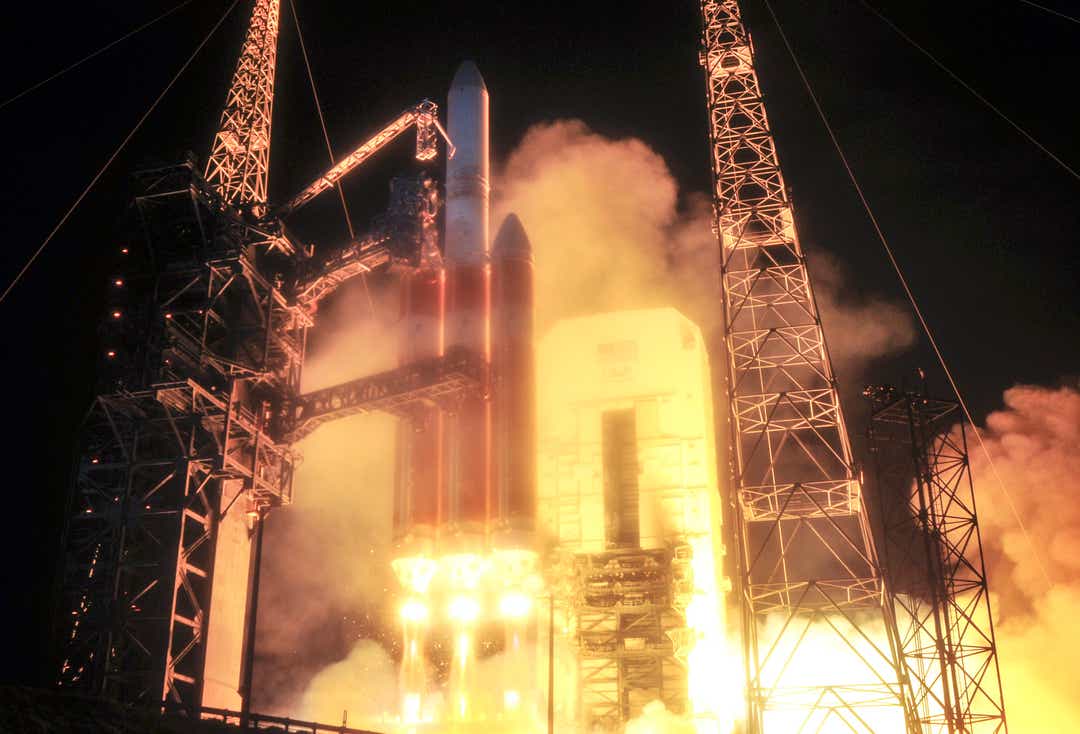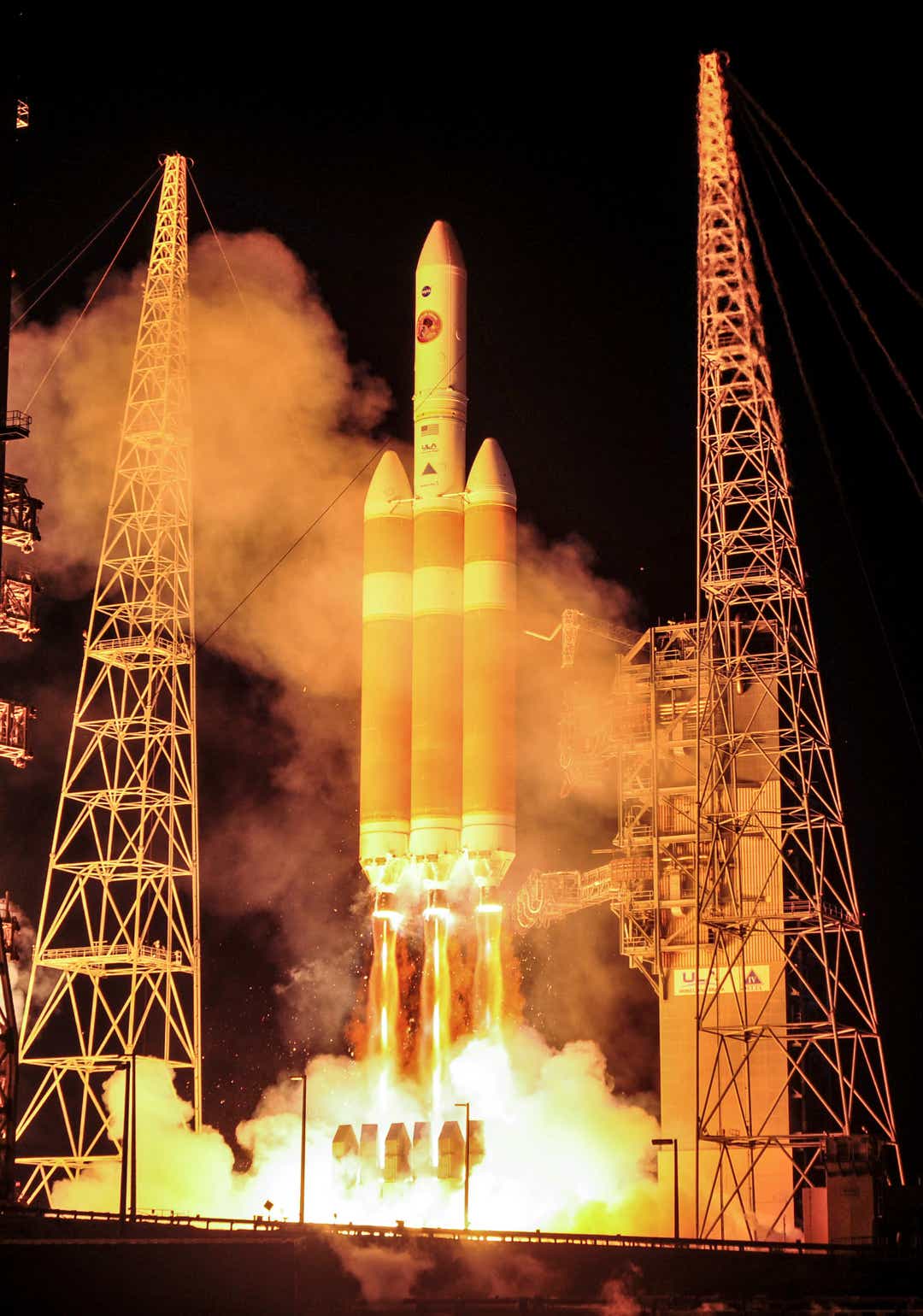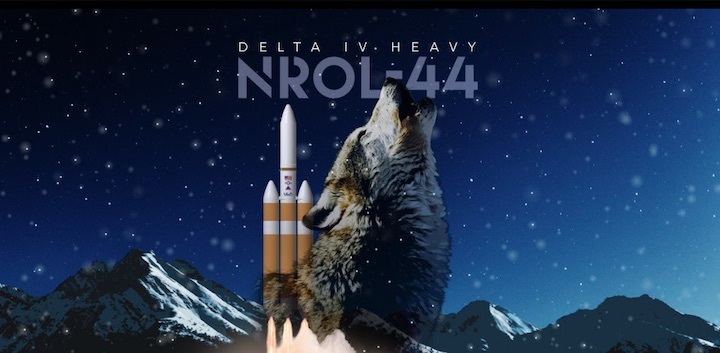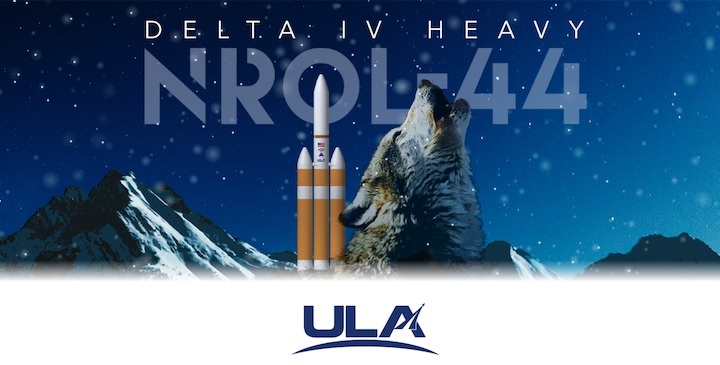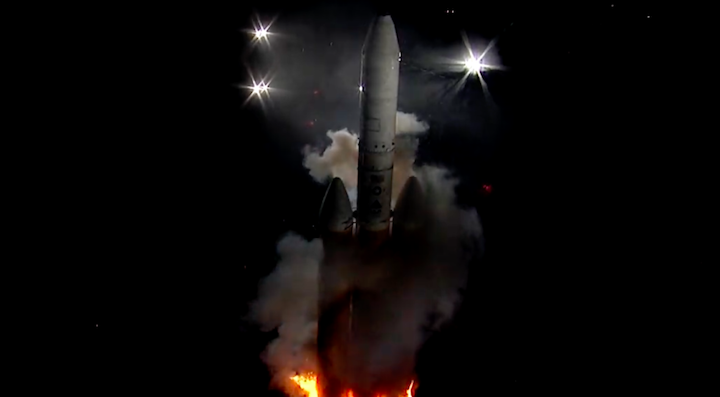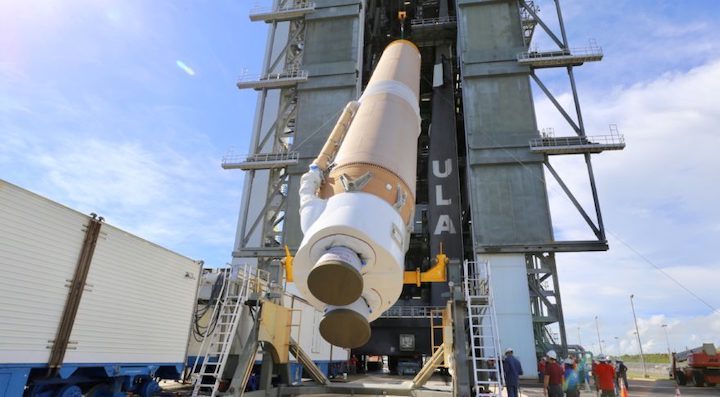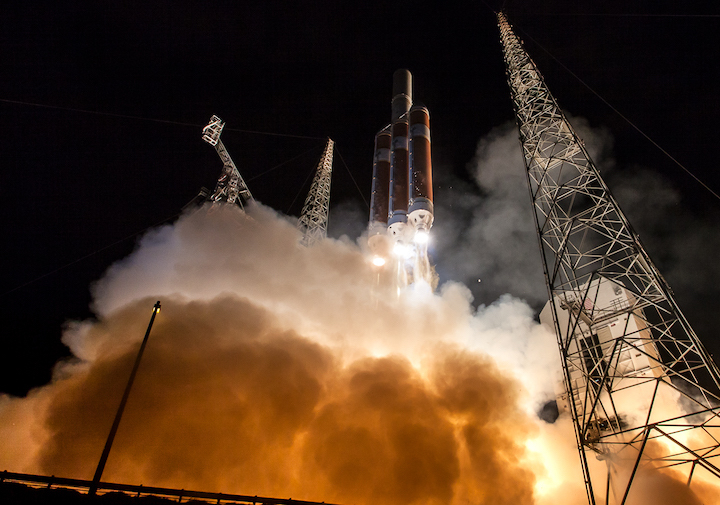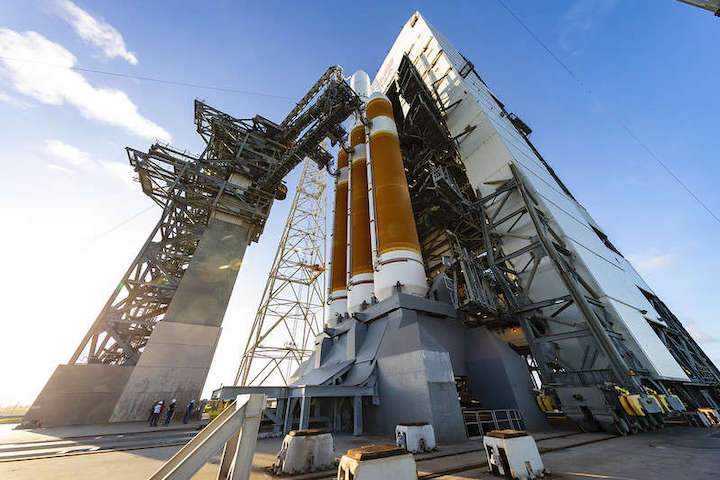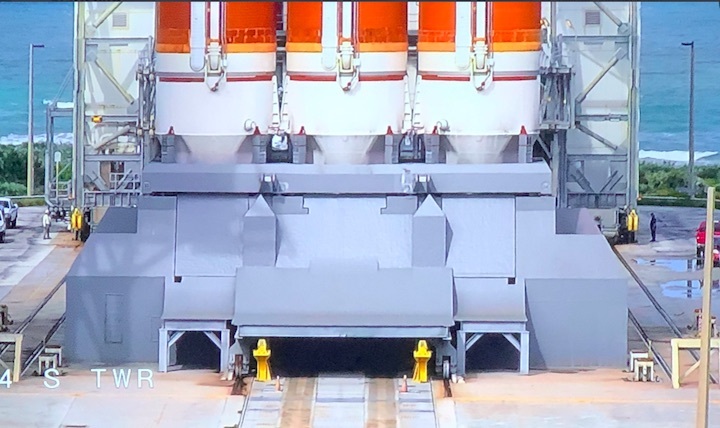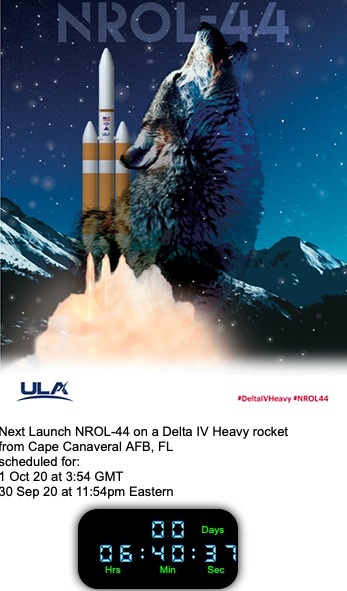18.11.2019
ULA kicks off next Delta 4-Heavy launch campaign
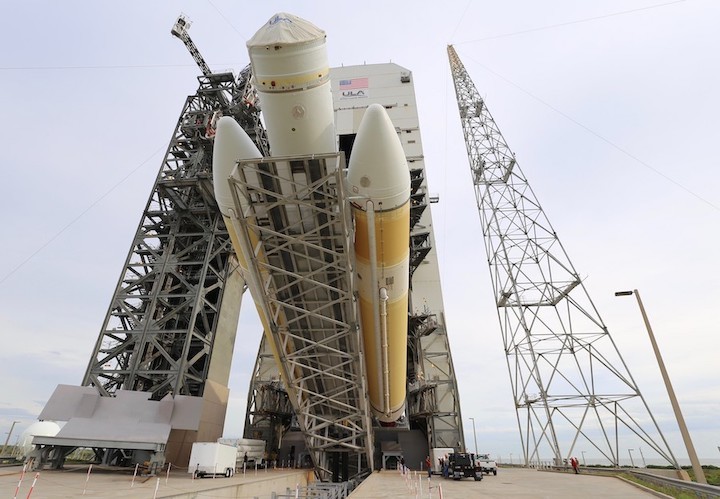
The next Delta 4-Heavy rocket was raised vertical Friday at Cape Canaveral, signaling the start of a comprehensive series of pre-flight testing before liftoff next year with a top secret U.S. government spy satellite.
The triple-core rocket rolled out to Cape Canaveral’s Complex 37 launch pad Thursday, riding a 36-wheel, diesel-powered transporter to the pad from United Launch Alliance’s nearby Horizontal Integration Facility, ULA said in an update posted on its website.
ULA’s ground team assembled the Delta 4-Heavy rocket inside the Horizontal Integration Facility. The Delta 4-Heavy is the most powerful rocket currently in ULA’s fleet, with three first stage boosters bolted together, each powered by a hydrogen-fueled Aerojet Rocketdyne RS-68A main engine.
According to ULA, teams inside the HIF connected the Delta 4-Heavy’s three common booster cores, then installed the rocket’s upper stage to the forward end of the core stage. Workers also added the Launch Mate Unit, a structure at the base of the rocket that includes 12 hold-down bolts. Pyrotechnic charges fire to release the bolts at liftoff, allowing the Delta 4-Heavy to climb away from the launch pad.
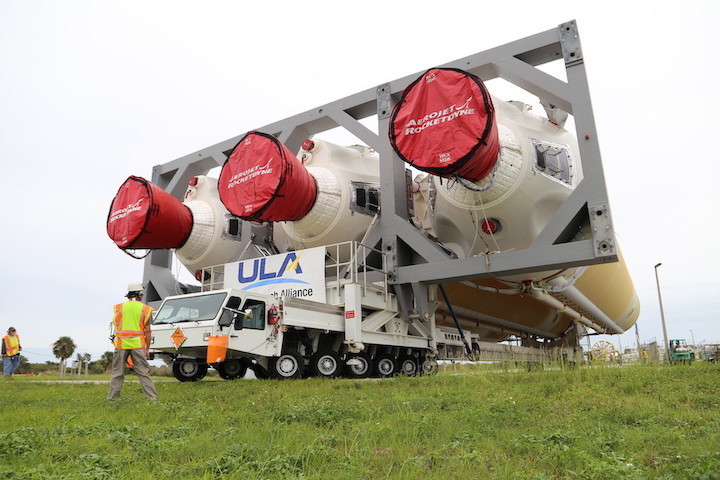
The Delta 4-Heavy is set to launch a classified payload for the National Reconnaissance Office, the agency which develops and owns the U.S. government’s intelligence-gathering spy satellites. The identify of the payload is top secret, and the mission is officially codenamed NROL-44.
The payload aboard the NROL-44 mission is likely heading for a high-altitude perch in geosynchronous orbit more than 22,000 miles (nearly 36,000 kilometers) above Earth, where the NRO operates surveillance satellites capable of eavesdropping on foreign communication signals.
If the NROL-44 payload is similar to previous NRO spy satellites launched into similar geosynchronous orbits, the Delta 4-Heavy rocket will deliver its spacecraft passenger directly to a circular orbit some 22,300 miles in altitude, a lofty orbit that typically requires three firings by the Delta 4’s upper stage RL10 engine.
ULA is building five more Delta 4-Heavy rockets for launches through 2023, all carrying payloads for the NRO that military officials say are unable to launch into their targeted orbits on any other rocket that is currently operational. Many of the NRO’s satellites are heavy and large — comparable to the size of a school bus — and are designed to be integrated with their rockets in a vertical configuration, rather than horizontally.
The launcher for the NROL-44 mission was raised vertical on its launch mount Friday. Teams positioned the rocket inside pad 37’s mobile gantry tower to prepare for a series of systems tests before the end of the year.
The Delta 4 team also plans to perform a wet dress rehearsal, during which ULA’s launch team will practice countdown procedures and fill the rocket’s cryogenic propellant tanks, then halt the launch sequence before engine ignition. The Delta 4’s tanks will then be drained, and the rocket will be readied to receive its top secret spy payload next year.
The NROL-44 mission is scheduled for launch in June, marking the 12th flight of a Delta 4-Heavy rocket since 2004, and the 41st Delta 4 mission overall.
The arrival of Delta 4-Heavy at pad 37 comes less than three months after ULA launched the final medium-lift Delta 4 variant Aug. 22. That mission signaled the retirement of the “single stick” Delta 4 rocket as the company focuses on flying the less expensive Atlas 5 launcher and developing the new Vulcan Centaur launch vehicle.
ULA plans another Delta 4-Heavy launch next September from Vandenberg Air Force Base, California, also hauling a classified NRO payload into orbit. Once teams complete testing on the Delta 4-Heavy at Cape Canaveral, ULA will ready the Delta 4-Heavy at Vandenberg for its mission at Space Launch Complex 6.

ULA crews transferred the Delta 4-Heavy rocket from the Horizontal Integration Facility at Cape Canaveral Air Force Station to the nearby Complex 37 launch pad Thursday, Nov. 14. Credit: United Launch Alliance
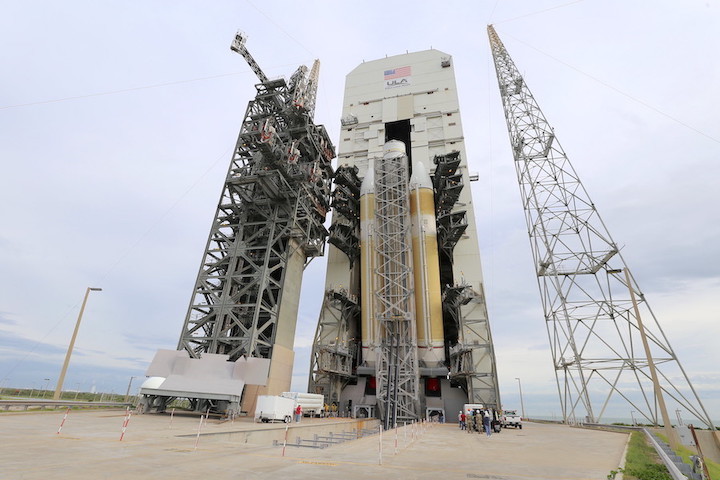
A hydraulic erector raised United Launch Alliance’s next Delta 4-Heavy rocket vertical at Cape Canaveral’s Complex 37 launch pad Friday, Nov. 15. Credit: United Launch Alliance
Quelle: SN
----
Update: 12.01.2020
.
ULA completes fueling test on next Delta 4-Heavy rocket
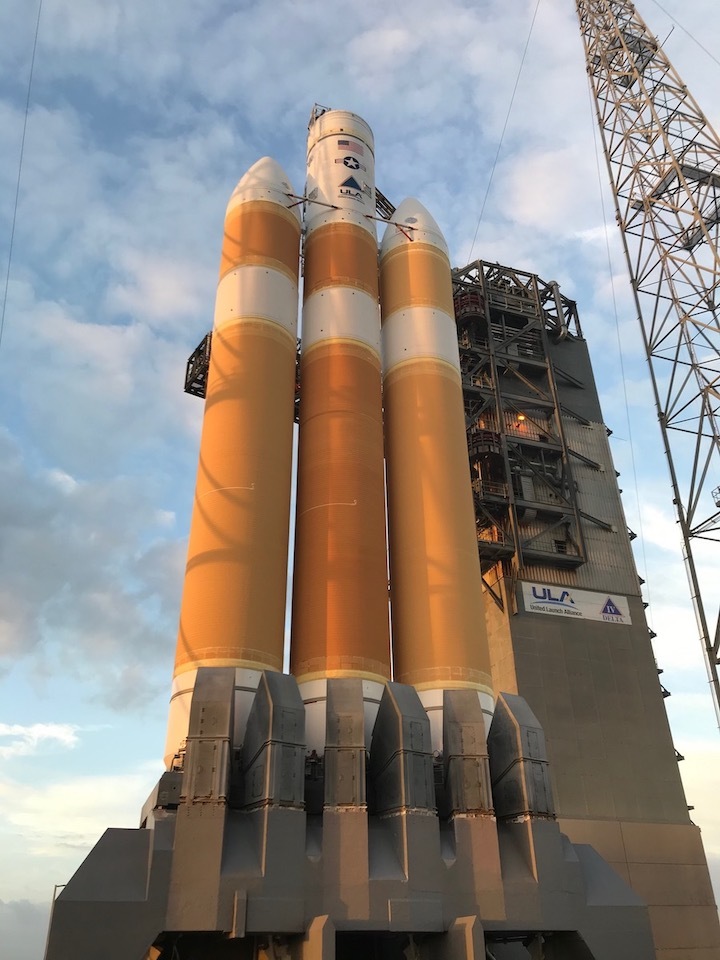
United Launch Alliance engineers filled a Delta 4-Heavy rocket with super-cold liquid hydrogen and liquid oxygen propellants Friday at Cape Canaveral Air Force Station during a practice countdown before the heavy-lifter’s scheduled liftoff in June with a top secret U.S. government spy satellite.
The countdown rehearsal Friday is known as a wet dress rehearsal. The mock countdown provided an opportunity for ULA’s launch team to practice launch day procedures and verify the Delta 4-Heavy’s readiness for flight, reducing chances of a problem cropping up during the real countdown.
About 465,000 gallons (nearly 1.8 million liters) of cryogenic propellants were loaded into the launcher during Friday’s mock countdown, starting with 330,000 gallons of liquid hydrogen for the Delta 4-Heavy’s three Common Booster Cores.
Another 120,000 gallons of liquid oxygen also flowed into the Common Booster Cores. An Aerojet Rocketdyne RS-68A main engine at the base of each booster will consume the hydrogen/oxygen propellant mixture in flight.
The Delta 4’s second stage, powered by an Aerojet Rocketdyne RL10 engine, was also loaded with a smaller amount of cryogenic propellant Friday.
The liquid hydrogen is stored at minus 423 degrees Fahrenheit, while the liquid oxygen is chilled to minus 298 degrees Fahrenheit.
Working from the Delta Operations Center near the Delta 4 launch pad, ULA’s launch team ran through pre-launch procedures before cutting off the countdown before the time the boosters’ RS-68A engines would ignite on launch day. The Delta 4-Heavy was then drained of propellant.
The wet dress rehearsal Friday came around two months after ULA ground teams erected the Delta 4-Heavy rocket — the most powerful vehicle in ULA’s inventory — on the launch mount at pad 37 in November.
The Delta 4-Heavy is set to launch a classified payload for the National Reconnaissance Office, the agency which develops and owns the U.S. government’s intelligence-gathering spy satellites. The identify of the payload is top secret, and the mission is officially codenamed NROL-44.
The payload aboard the NROL-44 mission is likely heading for a high-altitude perch in geosynchronous orbit more than 22,000 miles (nearly 36,000 kilometers) above Earth, where the NRO operates surveillance satellites capable of eavesdropping on foreign communication signals.
If the NROL-44 payload is similar to previous NRO spy satellites launched into similar geosynchronous orbits, the Delta 4-Heavy rocket will deliver its spacecraft passenger directly to a circular orbit some 22,300 miles in altitude, a lofty orbit that typically requires three firings by the Delta 4’s upper stage RL10 engine.
Liftoff of the NROL-44 mission from pad 37 is scheduled for June. It will mark the 12th flight a Delta 4-Heavy rocket since 2004.
ULA has five more Delta 4-Heavy missions its manifest through 2023, all carrying payloads for the NRO that military officials say are unable to launch into their targeted orbits on any other rocket that is currently operational. Many of the NRO’s satellites are heavy and large — comparable to the size of a school bus — and are designed to be integrated with their rockets in a vertical configuration, rather than horizontally.
The final launch of a Delta 4 rocket in its “medium” configuration with a single first stage booster occurred in August 2019.
With the completion of the wet dress rehearsal Friday, ULA says the launch team will complete post-test securing on the Delta 4-Heavy rocket then “pause” activities at pad 37 until closer to the launch date later this year.
One of the final major tasks before liftoff will be the raising of the NROL-44 payload and its payload fairing atop the Delta 4-Heavy a few weeks before liftoff.
Ground crews from ULA will be busy with other missions during the coming months, including a series of up to four Atlas 5 launches planned through mid-2020 from Cape Canaveral.
Preparations to stack another Delta 4-Heavy rocket on its launch pad at Vandenberg Air Force Base are also expected to commence in the first half of this year, ahead of its planned liftoff with another NRO spy satellite payload in late 2020.
Quelle: SN
----
Update: 17.04.2020
.
ULA delivers Delta 4-Heavy rocket to California launch base
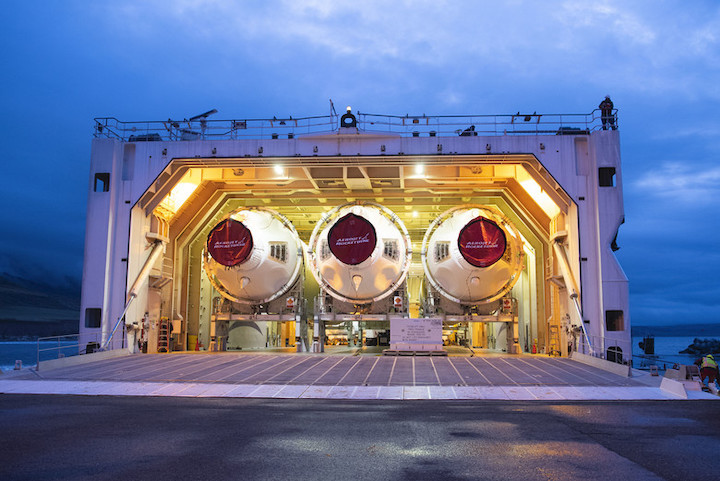
United Launch Alliance’s rocket transport ship has delivered a Delta 4-Heavy rocket to Vandenberg Air Force Base in California in preparation for launch of a U.S. government spy satellite late this year.
The Delta 4-Heavy’s three first stage boosters — known as Common Booster Cores — second stage and payload fairing arrived at Vandenberg on April 5 aboard ULA’s ocean-going transport vessel, named RocketShip.
The rocket delivery occurred during the global coronavirus pandemic, which has affected numerous sectors of the economy. But the federal government has deemed aerospace and defense-related businesses, including ULA, as essential functions that must continue operations during the public health crisis.
“We are continuing to work with our launch partners to ensure the Western Range remains postured to launch,” said Col. Anthony Mastalir, commander of the 30th Space Wing at Vandenberg Air Force Base, located around 140 miles (225 kilometers) northwest of Los Angeles.
“COVID-19 may be the threat at the forefront of everyone’s mind, and we are certainly taking all the necessary precautions to address that threat, but make no mistake, our national security still depends on our ability to launch rockets,” Mastalir said in a statement.
“We have been anticipating and planning this operation in coordination with ULA for several months,” said 1st Lt. Jasmine Toye, 2nd Space Launch Squadron mission integration manager. “No matter the circumstances, we have one job: perform the mission. Now is no different.”
ULA and military crews offloaded the Delta 4-Heavy rocket hardware over a six-day process and transferred the components to ULA’s Horizontal Integration Facility. Inside the horizontal hangar, ULA personnel will connect the rocket’s three Common Booster Core first stage elements to form a triple-body configuration and install the Delta 4-Heavy’s second stage over the next several months.
Then ULA will roll the rocket to Space Launch Complex-6, the Delta 4’s West Coast launch pad, and raise it vertical for a cryogenic fueling test and other checkouts. Finally, the Delta 4-Heavy’s classified National Reconnaissance Office payload and its launch shroud will be hoisted atop the rocket to cap assembly of the launch vehicle.
The Delta 4-Heavy rocket is being prepared for the NROL-82 mission scheduled for launch from SLC-6 at Vandenberg some time between Oct. 1 and Dec. 31 of this year.

The Delta 4-Heavy rocket is built at ULA’s factory in Decatur, Alabama, and transported to launch sites at Cape Canaveral for Vandenberg aboard the company’s RocketShip vessel. For trips to Vandenberg, the RocketShip sails down river channels to the Gulf of Mexico, then traverses the Panama Canal and sails northward in the Pacific to the spaceport on California’s Central Coast.
The NROL-82 mission scheduled for launch late this year will be 13th flight of a Delta 4-Heavy rocket — the largest vehicle in ULA’s current fleet — since debuting in 2004.
Another NRO spy satellite mission, designated NROL-44, is scheduled for launch on the 12th Delta 4-Heavy rocket in June from Cape Canaveral. That rocket is already stacked on pad 37 at Cape Canaveral and has completed a cryogenic fueling test before receiving its classified spy satellite payload in the final weeks before launch.
There are five Delta 4-Heavy rockets in ULA’s backlog remaining to launch through late 2023, all slated to loft NRO spy satellites into orbit.
The Delta 4-Heavy’s Common Booster Cores are each powered by a hydrogen-fueled Aerojet Rocketdyne RS-68A main engine. The three engines will generate 2.1 million pounds of thrust during launch.
The rocket’s second stage has a single Aerojet Rocketdyne RL10 engine, which also burns super-cold liquid hydrogen.
Quelle: SN
----
Update: 10.05.2020
.
Spy satellite launch on Delta 4-Heavy rocket delayed to August
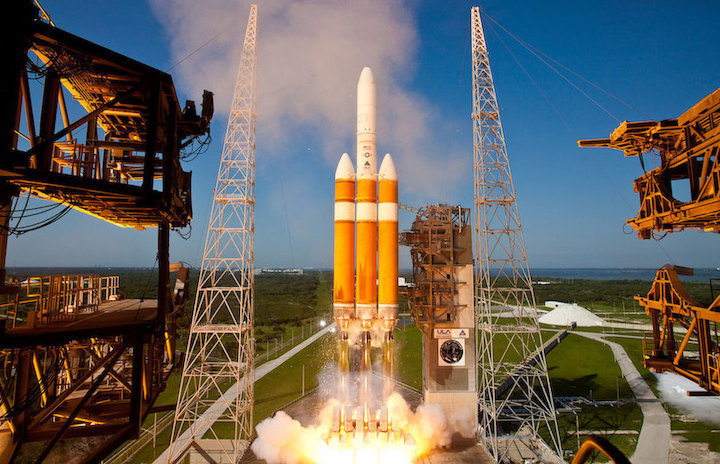
The next flight of United Launch Alliance’s triple-barrel Delta 4-Heavy rocket has been delayed from June to late August, military officials said Friday.
The heavy-lift rocket will carry a classified National Reconnaissance Office payload into orbit, likely targeting a geosynchronous station more than 22,000 miles (nearly 36,000 kilometers) over the equator, where the NRO operates surveillance satellites capable of eavesdropping on foreign communication signals.
The mission was previously scheduled to launch some time in June, but has been rescheduled for Aug. 26, according to Col. Robert Bongiovi, head of the launch enterprise division at the U.S. Space Force’s Space and Missile Systems Center.
Military officials did not disclose a reason for the two-month delay.
The Delta 4-Heavy rocket was transferred to Cape Canaveral’s Complex 37B launch pad last November, where ULA crews erected the launcher’s three first stage boosters and second stage on top of the launch deck.
In January, the Delta launch team loaded the rocket with around 465,000 gallons (nearly 1.8 million liters) of cryogenic liquid hydrogen and liquid oxygen propellants during a countdown dress rehearsal. The launch team drained the rocket of propellants after the simulated countdown.

Details about the Delta 4-Heavy’s payload is being kept secret by the NRO, the agency which develops and owns the U.S. government’s intelligence-gathering spy satellites. The mission is officially codenamed NROL-44.
If the NROL-44 payload is similar to previous NRO spy satellites launched into similar geosynchronous orbits, the Delta 4-Heavy rocket will deliver its spacecraft passenger directly to a circular orbit some 22,300 miles in altitude, a lofty orbit that typically requires three firings by the Delta 4’s upper stage RL10 engine.
The launch scheduled for Aug. 26 will mark the 12th flight a Delta 4-Heavy rocket since 2004.
ULA has five more Delta 4-Heavy missions its manifest through 2023, all carrying payloads for the NRO that military officials say are unable to launch into their targeted orbits on any other rocket that is currently operational. Many of the NRO’s satellites are heavy and large — comparable to the size of a school bus — and are designed to be integrated with their rockets in a vertical configuration, rather than horizontally.
The final launch of a Delta 4 rocket in its “medium” configuration with a single first stage booster occurred in August 2019.
ULA is also gearing up a Delta 4-Heavy launch later this year from Vandenberg Air Force Base, California. The rocket stages for that mission, designated NROL-82, recently arrived at Vandenberg from ULA’s factory in Alabama aboard a transport ship.
Quelle: SN
----
Update: 29.07.2020
.
Atlas V Rolls to Pad for Launch, as Delta IV Heavy Receives Secretive NROL-44 Payload
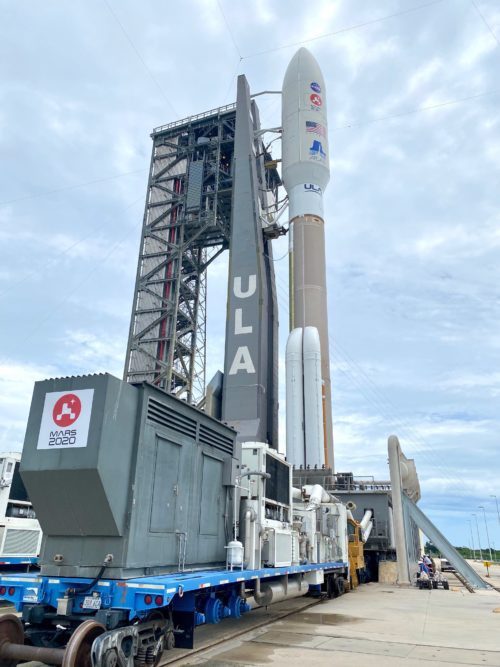
United Launch Alliance (ULA) stands ready to deliver NASA’s long-awaited Perseverance rover to Mars, having smoothly rolled out a giant Atlas V to historic Space Launch Complex (SLC)-41 at Cape Canaveral Air Force Station, Fla. The 197-foot-tall (60-meter) rocket—flying in its “541” configuration with a 17-foot-diameter (5-meter) payload fairing, four solid-fueled boosters and a single-engine Centaur upper stage—was carried the 1,800-foot (550-meter) distance from the Vertical Integration Facility (VIF) to the pad on Tuesday morning, atop the Mobile Launch Platform (MLP). Nicknamed “The Dominator” by ULA CEO Tory Bruno, the powerful 541 will certainly dominate much activity and attention in the next two days, as it sets out on America’s next voyage to the Red Planet.
Also early Tuesday, the highly secretive NROL-44 payload for the National Reconnaissance Office was hoisted atop its mammoth Delta IV Heavy booster, preparatory for launch from the Cape’s neighboring SLC-37B no sooner than 26 August
Quelle: AS
----
Update: 14.08.2020
.
Next Delta 4-Heavy launch on schedule for Aug. 26

The flight of a United Launch Alliance Delta 4-Heavy rocket set for Aug. 26 from Cape Canaveral continues the Delta rocket family’s countdown to retirement. With five Delta 4-Heavy missions left to launch, ULA’s chief executive Tory Bruno says there are no plans to build more as the company transitions to the next-generation Vulcan Centaur rocket.
The next Delta 4-Heavy launch is scheduled to blast off Aug. 26 from pad 37 at Cape Canaveral Air Force Station. ULA says the mission has a launch period opening at 1:50 a.m. EDT (0550 GMT) and closing at 6:25 a.m. EDT (1025 GMT), but the actual launch window lies within that period.
ULA’s heavy-lifter will carry a classified payload into orbit for the National Reconnaissance Office, which owns the U.S. government’s fleet of spy satellites. The mission, codenamed NROL-44, will mark the 12th flight of ULA’s most powerful rocket since its debut in 2004.
Seven of the previous 11 Delta 4-Heavy missions have carried NRO payloads into orbit. Others launched NASA’s Orion capsule on an unpiloted orbital test flight and NASA’s Parker Solar Probe on a scientific expedition to study the sun.
All five of the Delta 4-Heavy missions remaining in ULA’s backlog through 2023 will launch NRO satellites.
Military officials say the NRO payloads booked to launch on the remaining Delta 4-Heavy rockets are unable to launch into their targeted orbits on any other rocket that is currently operational. Many of the NRO’s satellites are heavy and large — comparable to the size of a school bus — and are designed to be integrated with their rockets in a vertical configuration, rather than horizontally.
The Delta 4-Heavy rocket is made up of three Delta 4 first stage booster cores bolted together. Each first stage core is powered by a hydrogen-fueled Aerojet Rocketdyne RS-68A main engine.
The final launch of a Delta 4 rocket in its “medium” configuration with a single first stage booster occurred in August 2019. ULA retired that configuration in favor of the Atlas 5 rocket, which can launch all but the heaviest NRO and military satellites.
With the introduction and certification of the next-generation Vulcan Centaur rocket — set for a debut launch in 2021 — ULA will be able to retire the Delta 4-Heavy and the Atlas 5.

SpaceX’s Falcon Heavy rocket, which the Air Force certified for national security launches last year, can lift heavier cargo into space than ULA’s Delta 4-Heavy, and at a fraction of the cost. The Air Force in 2018 awarded SpaceX a $130 million contract for a Falcon Heavy launch, less than half the current price of a Delta 4-Heavy.
But the Delta 4-Heavy has a larger payload fairing than the Falcon Heavy, giving it more volume for the biggest NRO satellites. And ULA’s ground facilities allow satellites to be integrated vertically with their rockets.
The Vulcan Centaur will have the same vertical integration capability, and SpaceX plans to offer vertical integration and an extended fairing for its Falcon Heavy rocket in the future.
The Pentagon announced Aug. 7 that ULA and SpaceX will share launch duties for the most critical military and NRO satellites through 2027, with ULA receiving a 60 percent share of the launch contracts, and SpaceX getting 40 percent.
The Defense Department awarded sole-source contracts to ULA for the five remaining Delta 4-Heavy launches. All the missions are considered “Category C” payloads in the Pentagon’s parlance.
Future Category C missions will be tasked to ULA or SpaceX as part of the military’s new launch contract awards announced last week, and will not be sole-sourced, military officials have said.
With ULA and SpaceX planning new rockets or upgraded launch capabilities — all at less cost than the Delta 4-Heavy — the Pentagon will no longer need ULA’s older rocket configurations.
Tory Bruno, ULA’s president and CEO, said in a recent interview that the company has no plans to produce more Delta 4-Heavy launchers.
“It’s not really practical anymore,” Bruno told Spaceflight Now. “We’ve got the five left. Two of them will go this year, and we have allowed the supply chain that supports the Delta 4-Heavy to begin drying up after the pieces that are already delivered.”
After the Aug. 26 mission, ULA is planning to launch another Delta 4-Heavy rocket before the end of the year from Vandenberg Air Force Base in California. That launch, designated NROL-82, is expected to deliver a sharp-eyed surveillance satellite for the NRO.
Three more Delta 4-Heavy rockets are being built for launches in 2022 and 2023 — two from Cape Canaveral and one from Vandenberg.

The Delta 4-Heavy rocket set for launch Aug. 26 was transferred to Cape Canaveral’s Complex 37B launch pad last November, where ULA crews erected the launcher’s three first stage boosters and second stage on top of the launch deck.
In January, the Delta launch team loaded the rocket with around 465,000 gallons (nearly 1.8 million liters) of cryogenic liquid hydrogen and liquid oxygen propellants during a countdown dress rehearsal. The launch team drained the rocket of propellants after the simulated countdown.
If the NROL-44 payload is similar to previous NRO spy satellites launched into similar geosynchronous orbits, the Delta 4-Heavy rocket will deliver its spacecraft passenger directly to a circular orbit some 22,300 miles in altitude, a lofty orbit that typically requires three firings by the Delta 4’s upper stage RL10 engine.
The Delta 4 launcher was originally designed and developed by Boeing in the 1990s. The Atlas 5 was developed by Lockheed Martin.
Boeing and Lockheed Martin merged their space launch divisions in 2006 to form ULA, a 50-50 joint venture between the two defense contractors.
Quelle: SN
----
Update: 25.08.2020
.
ULA ready for mighty Delta IV Heavy's 'special' launch from Cape Canaveral
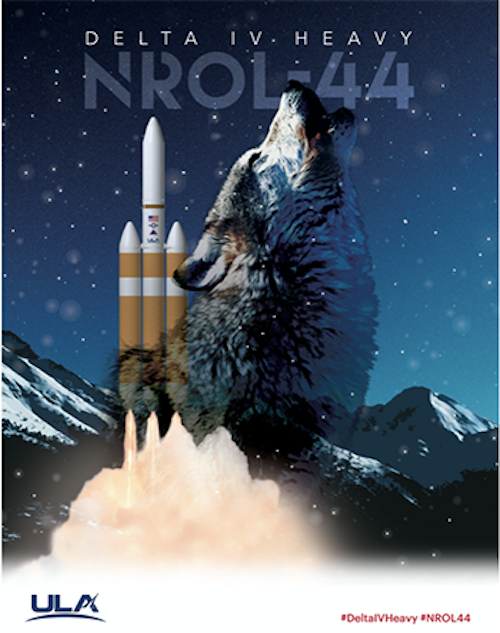
All rockets are special in their own ways, but United Launch Alliance's Delta IV Heavy takes a uniquely different approach: after its engines deliberately create a fireball, the rocket slowly rises, giving spectators ample time to see its three orange cores vault away from Cape Canaveral Air Force Station.
Early Thursday – 2:12 a.m. with an open window until 6:25 a.m. – will be the Space Coast's next opportunity to see the rarely launched, 235-foot rocket take flight from Launch Complex 37.
"Delta IV Heavy is a very special vehicle," Tony Taliancich, ULA's director and general manager of launch operations, said Monday. "It was designed to be able to lift the most critical, really big satellites into orbit that can't get there any other way."
Weather and visibility around the Cape should be promising for the attempt. The Space Force early Monday said conditions are expected at 80% "go" with cumulus clouds noted as the main concern.
"It's a very dramatic launch," Taliancich said. "And I also call it a majestic launch because it actually leaves the pad pretty slowly and it poses for pictures on the way out, so it's pretty cool to watch."
The three-booster vehicle, designed specifically for high-priority national defense satellites used by intelligence agencies and the military, flew its first full mission in 2007. It's found purpose in boosting science and human exploration missions, too – a Delta IV Heavy launched an uncrewed Orion capsule from the Cape in 2014 and, most recently, NASA's Parker Solar Probe in 2018.
Thursday's launch will mark its eighth national security mission. And despite its highly visible nature, neither ULA nor its customer, the National Reconnaissance Office, are allowed to say much about the intelligence-gathering payload, known as NROL-44.
"This particular payload has a huge number of special requirements like a really big payload fairing to be able to handle it," Taliancich said. "From a national security standpoint, these are extremely important space assets and they do really critical things for the United States."
Taliancich said one of the heavy-lift rocket's advantages over its smaller Atlas V sibling is the ability to take payloads directly to geosynchronous orbit, meaning satellites don't have to expend as much fuel to raise their orbits thousands of miles above Earth. More available fuel onboard means more maneuvering flexibility and more time in service.
But Atlas V isn't its only relative – a single-core variant of Delta IV, also known as the "single-stick" version, also flew until August of last year. It launched dozens of missions over its nearly 20-year service window.
Delta IV Heavy also has a home at Vandenberg Air Force Base in California, where it has launched three missions to date. Looking forward, the rocket is contracted to fly four more missions evenly divided between the Cape and Vandenberg.
If schedules hold, Delta IV Heavy is kicking off an unusually active week for the Eastern Range. A SpaceX Falcon 9 rocket is slated to take an Argentinian communications satellite to orbit from Launch Complex 40 no earlier than 7:19 p.m. Friday, though it could push slightly due to its timing proximity to the Delta mission. When it does launch, it will include a booster landing at the Cape, generating sonic booms that will reverberate across the Space Coast.
Less than two days after that, yet another Falcon 9 will boost the company's twelfth Starlink satellite internet mission from Kennedy Space Center's pad 39A. Teams are tentatively targeting around 10:30 a.m. Saturday, which will include a drone ship landing in the Atlantic Ocean.
Contact Emre Kelly at aekelly@floridatoday.com or 321-242-3715. Follow him on Twitter, Facebook and Instagram at @EmreKelly. Support his space journalism by subscribing at floridatoday.com/specialoffer/.
Launch Thursday
- Rocket: United Launch Alliance Delta IV Heavy
- Mission: Undisclosed National Reconnaissance Office payload
- Launch Time: 2:12 a.m.
- Launch Window: Until 6:25 a.m.
- Launch Complex: 37 at Cape Canaveral Air Force Station
- Join floridatoday.com/space starting at 12 a.m. Thursday for countdown chat and live video.
Launch Friday
- Rocket: SpaceX Falcon 9
- Mission: SAOCOM-1B commercial communications satellite
- Launch Time: No earlier than 7:19 p.m.
- Launch Window: TBD
- Launch Complex: 40 at Cape Canaveral Air Force Station
- Join floridatoday.com/space starting at 5:30 p.m. Friday for countdown chat and live video.
Launch Saturday
- Rocket: SpaceX Falcon 9
- Mission: Twelfth batch of Starlink internet satellites
- Launch Time: 10:30 a.m.
- Launch Window: TBD
- Launch Pad: 39 at Kennedy Space Center
- Join floridatoday.com/space starting at 9 a.m. Saturday for countdown chat and live video.
